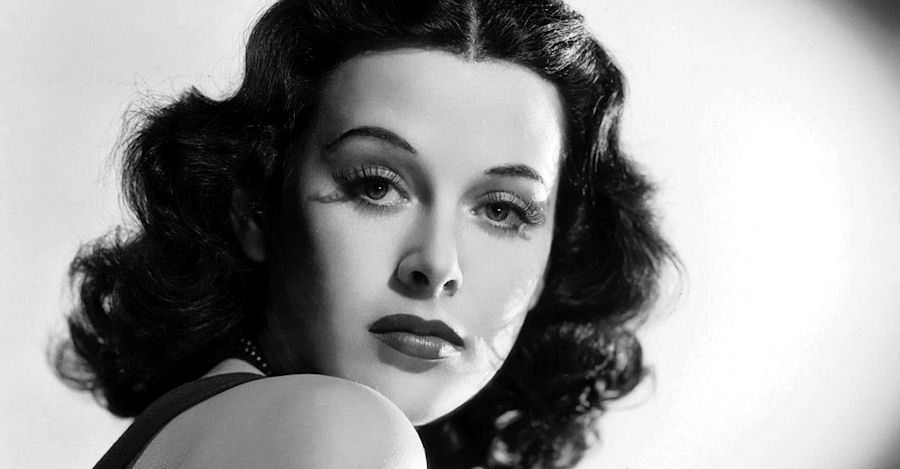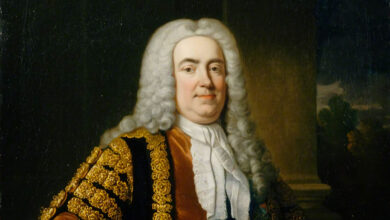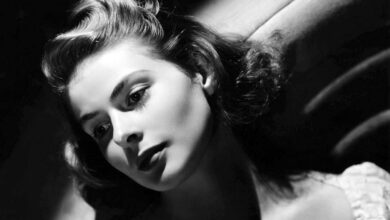
“Any girl can be glamorous. All you have to do is stand still and look stupid” – Hedy Lamarr
Podcast: Play in new window | Download
Subscribe: Spotify | Amazon Music | Youtube Music | RSS
Hedy Lamarr Biography
The next time you place a call on your smartphone, use Bluetooth, or Wi-Fi, you might pause and whisper a word of appreciation to Hedwig Kiesler Markey. She was one of the pioneers of frequency hopping spread spectrum technology that made wireless communication possible. She also was one of the acknowledged Hollywood goddesses of MGM’s “Golden Age”. She was Hedy Lamarr.
Hedy Lamarr was born Hedwig Eva Maria Kieslerin in Vienna, Austria-Hungary, on November 9, 1914. Her mother was Gertrud Lichtwitz Kiesler, a Budapest-born concert pianist of the Jewish haute bourgeoisie – the upper class of Jewish residents of Vienna who built their wealth from trade and industry. Hedy’s father, Emil Kiesler, was a secular Jew from Lemberg (part of the Austro-Hungarian Empire). In addition to being a successful banker, Emil loved technology and conveyed his enthusiasm to his only child.
Hedy lived a life of relative privilege, attending schools in Vienna and a finishing school in Switzerland. By the time she left finishing school, she had become an exceptionally beautiful young woman and she moved from the schoolroom to the movie soundstage. She began her movie career in 1930, appearing in two Austrian films, Storm in a Waterglass, and Money on the Street.
Several small roles in German-language films followed but it was the Czechoslovakian film, Ecstasy that launched her career and garnered the young actress a certain amount of notoriety. She was 18 when she briefly appeared naked in several scenes, and in an apparent moment of orgasm (filmed in close-up) in another scene. Hedy would later write of this film in her autobiography, Ecstasy and Me, stating that the appearance of orgasmic passion was due to “method acting reality” and also that the off-screen film director periodically poked her bottom with a safety pin.
Hedy had married her first husband, Friedrich Mandl in 1933. He was a munitions manufacturer and was reputedly, the third richest man in Austria. Although he was half-Jewish, he had social and business ties to the German and Italian fascist governments.
Mandl was distressed at what he considered to be the exploitation of his wife and is said to have bought up as many copies of the Ecstasy as possible. Lamarr later asserted that her husband was extremely controlling and had tried to restrict her acting career by keeping her a virtual prisoner in Schloss Scharzenau, their castle home. She wrote that they hosted lavish parties for Mussolini and Hitler, and that Mandl expected her to accompany him to military technology business meetings.
Unable to tolerate the marriage, Hedy fled to Paris, then London where she met movie mogul Louis B. Mayer. It was Mayer who insisted that her name be changed to Hedy Lamarr, and as Hedy Lamarr, she would make her American film debut in the movie Algiers opposite established leading man, Charles Boyer.
Soon declared, “The Most Beautiful Woman in Film”, Hedy would spend the majority of her Hollywood career paired in film with the leading men of the era – Clark Gable, Spencer Tracy, John Garfield, Robert Young, and Victor Mature. Actor George Sanders was quoted as saying that Lamarr was “so beautiful that everybody would stop talking when she came into a room.” She most often was cast as the archetypal exotic and glamorous seductress in drama and adventure films with rare roles in comedy. She finished her Hollywood career in 1951, appearing in films only sporadically thereafter.
Her film career might have been limited (and limiting) but Hedy had other interests to explore. One of her California neighbors, George Antheil, was a composer and inventor noted for his successful experiments with automated control of musical instruments.
Hedy and George discussed the possibilities of interrupting the course of radio-controlled torpedoes after they had been launched. She had absorbed a certain amount of technical knowledge regarding torpedoes from attending her former husband’s business meetings. She and George co-invented a ‘“Secret Communications System’ to help combat the Nazis in World War II. By manipulating radio frequencies at irregular intervals between transmission and reception, the invention formed an unbreakable code to prevent classified messages from being intercepted by enemy personnel.”
She and George were awarded a patent in 1942 and donated it to the war effort. Ironically, it was not utilized in World War II but was installed on the ships that blockaded Cuba during the Cuban Missile Crisis of 1962. Even more ironic, this use was three years after their patent had expired and neither ever received compensation for their patent.
This remarkable patent would become the catalyst for the use of Spread Spectrum – the use of radio frequencies at the same time, “without interfering with each other. This is the basis for the cellular phones, faxes, and other wireless communications systems in widespread use today.” The Secret Communication System is also used extensively in military communications.
Hedy Lamarr married six times and had three children one of which was adopted. She made fewer than 30 films in her career and had retired from film making completely by 1958. In later years, she would be twice arrested for shoplifting. Only late in life would she begin to receive (along with her co-inventor, George) the much-deserved recognition for their frequency hopping, spread spectrum invention.
Unfortunately, recognition for their co-invention came years after George’s passing but Hedy lived long enough to enjoy belated recognition and growing appreciation for her accomplishments. George Antheil and Hedy Lamarr were awarded the Electronic Frontier Foundation Pioneer Award in 1997. Also in that year, Lamarr was presented the BULBIE Gnass Spirit of Achievement Bronze Award which is presented to “those individuals whose creative lifetime achievements in the arts, sciences, business, or invention fields have significantly contributed to society or the earth at large”. She was BULBIE’s first female recipient.
Hedy Lamarr retired to Florida, living quietly there until her death on January 19, 2000 at the age of 85. She is remembered for her great beauty, her movies, some notoriety, and also – after a long wait – for being a technological visionary.
Podcast: Play in new window | Download
Subscribe: Spotify | Amazon Music | Youtube Music | RSS




